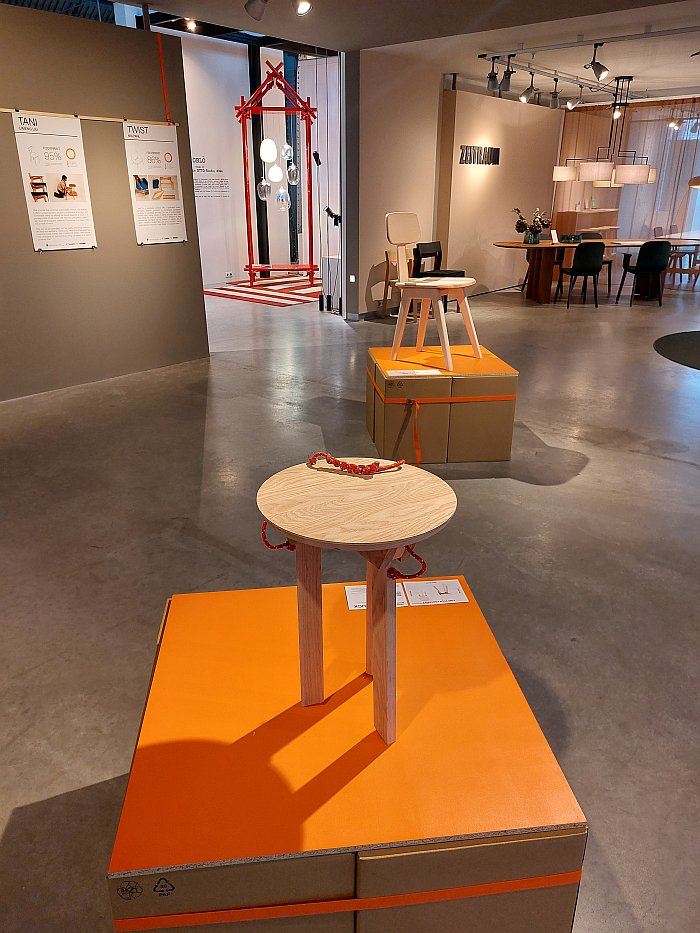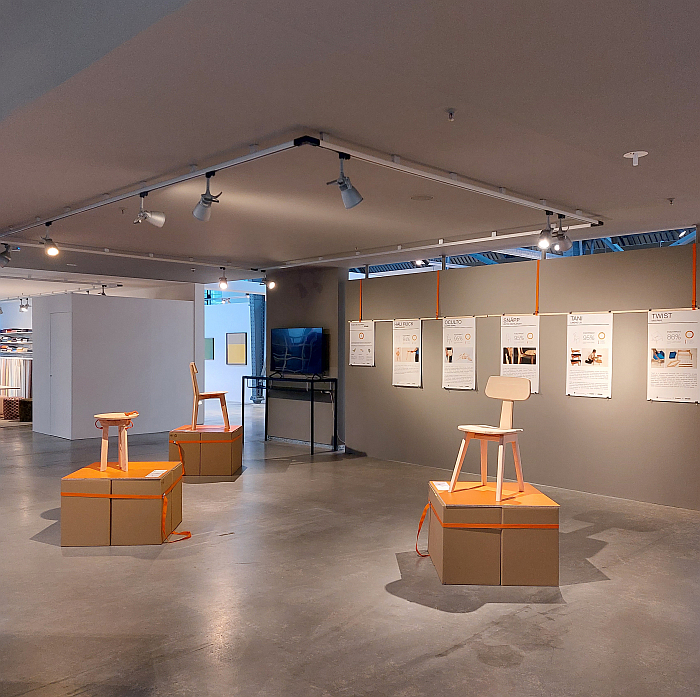
Cologne's Design Post is, arguably, one those institution's that would have been shocked at the previously discussed cancellation of IMM Cologne 2025.
Sited, one feels very deliberately, across the road from the Cologne trade fair complex, as a permanent showroom space for more design orientated furniture and lighting publishing houses, if one so will, a shop for contract customers, a B2B shop, Design Post exists during IMM and Orgatec as an unofficial exhibition hall, not only hosting those manufactures who, for whatever reason, choose to eschew Kölnmesse, but also serves as a location for parties, launches, parties, events, parties, presentations for many of those to be found within Kölnmesse's halls.
And is always worth crossing the road for.
There was no IMM Cologne in January 2025.
Design Post was still worth crossing the road for in January 2025. If from Messe/Deutz railway station rather than from the Messe itself.
And that not least because in context of the 2025 edition of Pasasgen Interior Design Week Design Post played host to a presentation of the results of the project Find Your Footprint staged at the Universität der Künste, Berlin, under the guidance of Prof. Ineke Hans and run in cooperation with Bavarian furniture manufacturer Zeitraum and Danish textile manufacturer Kvadrat. A project which challenged the students less to find their footprint as to design a furniture object with a footprint reduced to a minimum; if one so will to explore that aspect of reduction in furniture design and production that over the decades has been overshadowed by, ignored through, a focus on a more conceptual, aesthetic reduction, and thus a shift of emphasis in and of "reduction" that neatly embodies an appreciation in recent years of the relationships between furniture design and production and resource usage and exploitation. And of the urgent need to adjust those relationships.
And a project which resulted in twelve proposals, five of which were presented in Design Post during Passagen 2025.
Five proposals that as with all student works needs must be understood as the expression of the individual student's approach to the challenge in context of a semester project, needs must be understood as a component of the individual student's development of their positions, their approaches, their appreciation of materials, their questioning of relationships between form and function, of relationships between user and object, of the place and role of design and the designer in society, etc, etc., etc. Needs must be understood as a component of finding one's way forward undertaken in a specific and closely defined context that very naturally excludes numerous options that under less constrained conditions could greatly influence and inform the end result. And is never about a commercial project. The realised objects don't have to work perfectly, don't have to be realistic in a serial production context, in many regard it's better if they're not. It's the whys, hows, wherefores, that which the object embodies and expresses and discusses, the arguments they make, that's important. Not the potential commercial success of the object.
A non-commercial, experimental approach, the projects as extrapolated brainstormings within closely defined parameters, tending to be underscored by the fact that with none of the quintet did we get the impression a chair was being sought by the respective student; rather the works all spoke to us as expressions of construction, functionality, exchange with the user beyond sitting and support, etc. Whereby, all five objects were sitting solutions, which wasn't part of the brief, that just mentions 'furniture'; that all five are seating solutions arguably being a further underscoring of not only the depth of the relationships between humans and chairs, but the reality that through that relationship chairs are a preferred medium of choice for creatives via which to present their positions and discuss contemporary realities. That you can explain yourself more effectively in a chair than in a table, sideboard, hat stand etc, because the viewer has a better developed relationship with chairs than with tables, sideboards, hat stands etc.
The explanation, the measurement, of the degree to which the students had realised an object with a low footprint, that defining component of the project, being undertaken via the, from Zeitraum developed, Furniture Footprint, a comparative evaluation system that employs a number of ecological, economic and social factors, along with data from the German Federal Ministry for Housing, Urban Development and Building's so-called Ökobaudat life cycle assessment platform, to grade any and every piece of furniture, with 100% being best. Whereby if it's a footprint that's being measured one can't help thinking 0% is the more natural aim. But, that's probably just us not understanding something. And although, unless we missed it, apologies if that is the case, Zeitraum somewhat regrettably don't publish an exact explanation of the math they use to calculate the footprint of any particular object, don't publish the exact criteria and their weighting within the calculation, don't allow access to the inner workings, just the end number, Furniture Footprint does allow a basis for a comparison, also between the same object in a different material. Another of those popularly ignored aspects of a contemporary furniture industry that loves to produce the same object in a variety of materials, not least as limited special editions with their increased marketing fuelled resource usage. And thus something that should perhaps be less popularly ignored than it is.
In no particular order.......
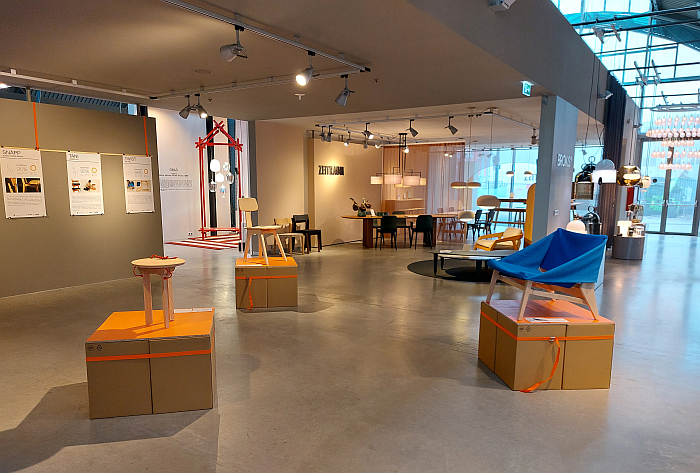
Expressing itself as a nicely proportioned multi-purpose/kitchen chair with the backrest and seat linked via a single length of wood that, presumably, offers a small degree of sitting resilience, the central feature, the core, of Oculto is, in many regards, the magic, mysticism and alchemy the name implies. If a magic, mysticism and alchemy that, for all one can believe in them, the chair before you explains the rational basis to your observations. Specifically via the most delicious use of the dovetail joint, one of those classics of traditional carpentry, that Laurin has employed as the basis for a construction system that, according to Laurin, who we don't doubt, but we haven't seen the system in action, allows for not only a flat-pack object with all the sales and distribution advantages that brings with it, but also an object that can be dismantled and reassembled, be that to enable repairs or to reduce volume when moving house. And that in an object whose dovetail joints talk convincingly of the rigidity and invincibility of time; a very nice toying with your perceptions. In addition Laurin's dovetail system, we'd argue, without knowing, also allows the chair to be the basis for a family of furniture objects, potentially a modular system, thereby introducing the responsiveness and mutability that's also an important aspect of reducing the furniture industry's footprint.
More information on Laurin Höhne can be found on Instagram @laurin132design
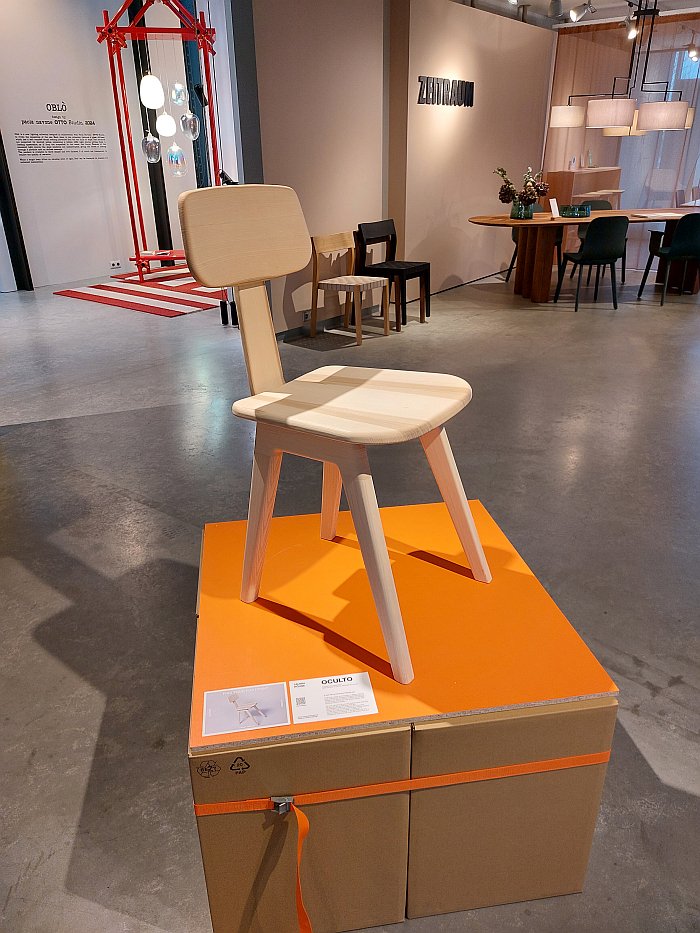
Snäpp is Swedish for Snap, and that is, in many regards, exactly how one constructs Anton Oberländer's chair from the flat-pack components in which you receive it. They snäpp together. If one can also Lossa, Unsnap, the construction and then Knäpp Igen at a later date and/or different location, we no know. But such information doesn’t detract from an object that through its reliance on just four components simplifies not only the production, itself an important component of footprint reduction, but also the assembly by the user. An object whose milled grip in the backrest arguably isn't functionally necessary but which does provide a very simple graphic element that expands the object's character, which, yes, does make it functionally necessary; and whose angularity and the flatness, almost one dimensionally so, of the seat, bequeaths it a visual lightness, allows it to take up a lot less visual space than the physical space its does, reduces its visual footprint. A reduction that is important when placing furniture in any compact contemporary domestic interior, or any compact restaurant space.
More information on Anton Oberländer can be found on Instagram @antonoberlaender
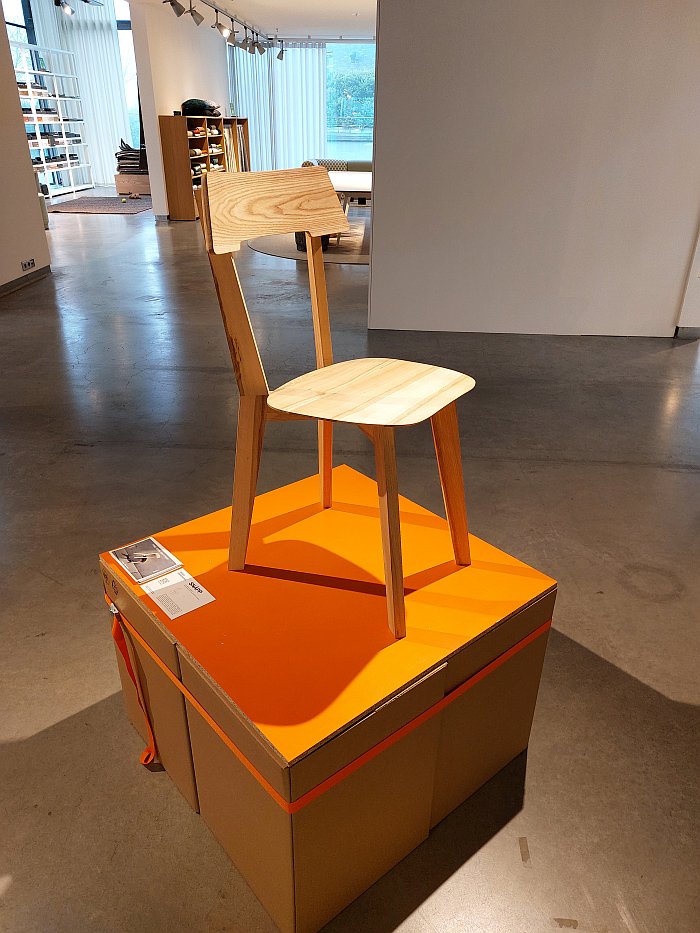
The only upholstered object on show, and thus the only one of the quintet on show in Design Post that remembered Kvadrat were also a project partner; if an inclusion of textiles that appears primarily responsible for a footprint evaluation far below that of the other four works. If a work that comes in with a better footprint score than, as far we see, all upholstered objects currently in the Zeitraum portfolio. An improved footprint in contrast to the existing Zeitraum portfolio, arguably, because it does away with foam cushioning and relies instead on the stretching of a piece of textile across the frame by way of a seat, backrest and armrests; a much employed trick in the (hi)story of furniture design that places a lot of responsibility on the material, a lot of responsibility on the designer and manufacturer in the choice of material. But which when properly done is most satisfying. Especially when as in the case of Twist the textile can be removed by the user for either washing or repairing or exchange in context of a new use context or a new (corporate or private) colour scheme. A further negative aspect in the footprint evaluation appears to be the use of steel fittings; in how far they needs must be steel, we no know, but if they needn't be, it does sound like the sort of aspect that can and should be altered in a further development thereby aiding a reduction in the footprint. And which reminds that in all contexts, there are always things that can done alternatively with positive effects. The trick is identifying them, and identifying why they need changing.
More information on Mia Pahl can be found on Instagram @mia.pahl
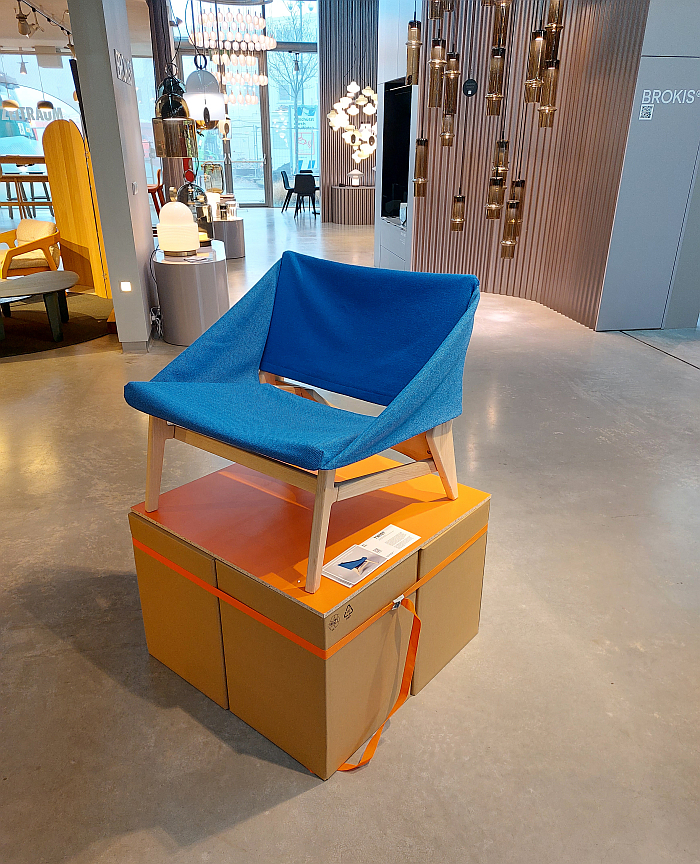
Resilient wooden chairs ain't new, but generally they announce their resilience with large fanfare: are either monumental cantilevers of the type the Aaltos realised in the 1930s, and which the operator of ubiquitous blue and yellow warehouses next to motorways later took up with great gusto, or are flowing twisting works, as if formed from a stream of molten wood, which as 3D printed objects they could and can be. Tani announces its resilience in a much quieter fashion. Almost doesn't announce it. But as you approach Tani you are very aware of an incongruity between seat and rear legs, not a distasteful, irritating incongruity, in many regards pleasing, it's more that the line your eye charts isn't that which your brain expects. An incongruity brought about by two pieces of ash within the otherwise oak construction which bend when the chair is sat on, thereby dropping the rear of the seat and closing the gap betwixt rear legs and seat. And cushioning the sitter. Ash bands which, one assumes, also respond to changes in the seating position enabling a responsive resilience. How well that works, and what the experience is like, two important components of any chair design, we were unable to test, but as a concept, as a construction principle, as a re-imagining of not just wooden chairs but resilient seating as we approach the 100th birthday of the steel tube cantilever Tani certainly works most satisfyingly.
More information on Limeng Liu can be found on Instagram @lim_cq
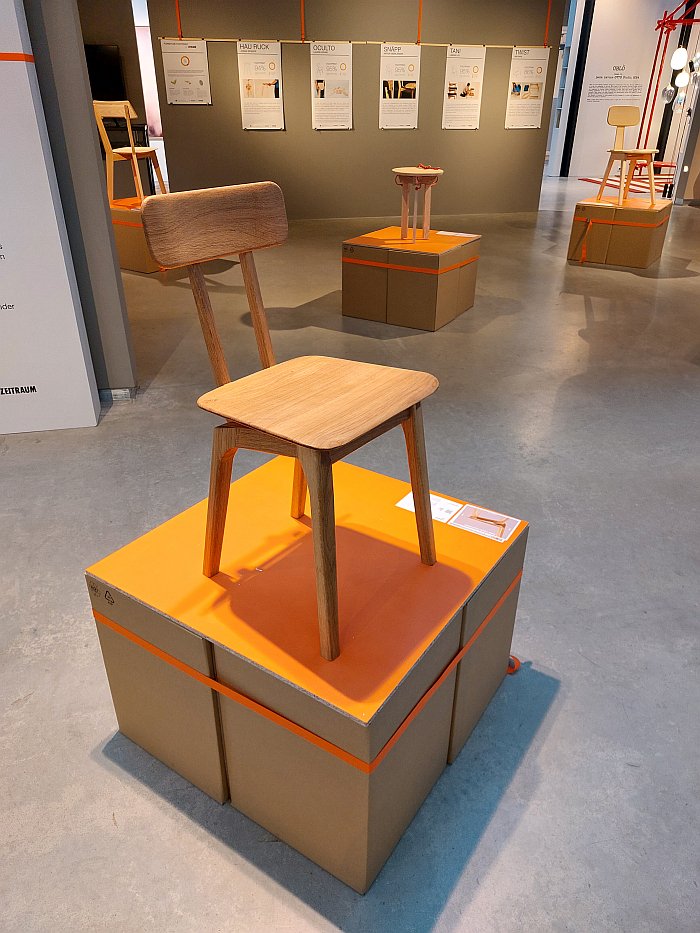
Hau Ruck is best translated into English as Heave-Ho and implies the rhythmic repetition of the same action be way of achieving a desired result, such as, for example, rowing a boat, or sawing through a giant redwood trunk with a two-person saw, or hand-riveting a steel bridge, etc. And while there is an element of repetition to achieve a desired result within the principle around which Jonas has based his stool design, it's a lot less strenuous than much hau ruck: You pull on a cord and Hau Ruck transforms from a loosely hanging collection of components into a stool. Retract the cord and that stool collapses back into that loosely hanging collection of components which can be stored flat or hung up. And re-transformed to a stool as and when required. Much like those small wooden animals/clowns/etc which stand on a pedestal, and where when you push at the base of the pedestal the creature collapses, release your finger and they stand erect. Or at least does so according to Jonas, who, again, we don't doubt, but, again, we haven't experienced it in action, and we've suffered too much disappointment over the years to let ourselves be taken in by anything as fragile as a promise. A stupidly simple system that offers practical storage options, and a novel take on flat-pack and pop-up, the developed system also bequeaths the object a very pleasing playfulness; furniture needn’t be playful, there is no requirement for furniture to be playful, but playfulness does expand the functionality, expands the definition of function. As does the manner in which one can easily imagine Hau Ruck effortlessly, and unquestioningly, taking on any and every corporate identity programme or marketing cooperation.
More information on Jonas Spieker can be found on Instagram @jonas.p.spieker
Background information on Find Your Footprint, including details of the brief, and more information on all proposals realised in context of the project, can be found at https://design.udk-berlin.de/find-your-footprint
Passagen Interior Design Week 2025 has now ended, details of the event and what you missed can be found at www.voggenreiter.com/passagen2025
